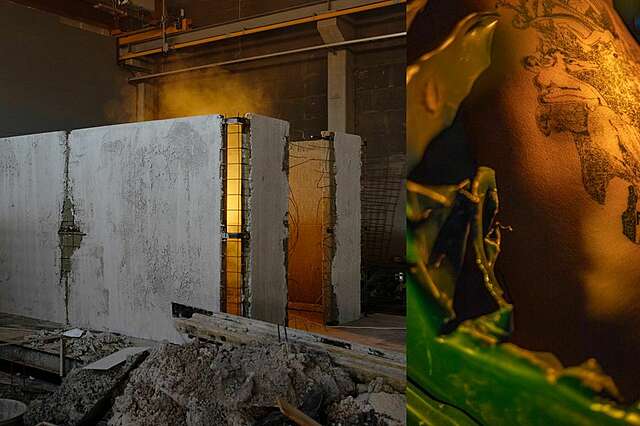Pavilion of Finland introduces composting toilet to Venice – 'Huussi' exhibition at the Biennale Architettura 2023 envisions a sanitary solution that saves water and recycles nutrients

HUUSSI RY, BIOLAN, METSÄHALLITUS, ANTERO JOKINEN, EMMI KESKISARJA, ARJA RENELL
The Pavilion of Finland will present The Dry Collective's exhibition Huussi, Imagining the future history of sanitation at the 2023 Biennale Architettura. The exhibition deals with the architecture of water and nutrient circulation and questions the sanitary solution we take for granted, the water toilet.
The exhibition Huussi – Imagining the future history of sanitation, produced by Archinfo – Information Centre for Finnish Architecture, critically reassesses our sanitation system at a time when the sufficiency of drinking water and food production is a global problem.
"The theme of the exhibition to be seen in the Pavilion of Finland is very topical. According to Lesley Lokko, chief curator of this year's International Architecture Exhibition of La Biennale di Venezia, architects have the ability to present ambitious and creative ideas that help us imagine a more just and optimistic shared future. This also encapsulates the content of the exhibition designed by The Dry Collective: architects can together find solutions to global problems, and in this way, architecture can serve the society," says Katarina Siltavuori, director of Archinfo and commissioner of the exhibition.
The exhibition draws from Finnish cultural heritage: huussi is the Finnish word for outhouse – a composting toilet commonly used by Finns, particularly in rural settings and summer cottages.
"It is natural for Finnish architects to bring up the topic, open a discussion in the international arena and challenge the profession at a time when we must actively look for more sustainable solutions in all areas of society. The exhibition emphasizes the role of architects in finding solutions to social issues and defenders of the common interest and the environment," says Huussi exhibition curator Arja Renell.
Current consumption habits combined with population growth and climate change have led to water shortages around the world, including in Europe. This was clearly visible, for example, in the drying up of the Rhine and Po rivers in the summer of 2022, and according to the British government, the lack of water is already a threat to our existence. The exhibit in the Pavilion of Finland asks whether it is any longer justified to use 30 percent of our water to flush down excrement.

An infrastructure based on a flushing toilet also wastes nutrients necessary for food production. Since the end of the 19th century, agriculture has mainly used chemical fertilizers, the production of which destroys nature and pollutes waterways and groundwater. The production of nitrogen fertilizers causes huge greenhouse emissions, and the production of phosphorus fertilizers is based on the mining industry, which causes permanent damage to the environment. Chemical fertilizers also destroy the microbiome of the soil and eventually lead to the impoverishment of the farmland.
A large part of the nutrients contained in faeces, especially nitrogen and phosphorus, are lost in chemical wastewater treatment processes or end up in waterways where the nutrients cause eutrophication. The exhibition, which envisages a wider utilization of dry toilet solutions, highlights, in addition to saving water, how, if properly separated and composted, the nutrients in faeces can be effectively recycled and returned to food production.
"Huussi, the outhouse, serves as a kind of sympathetic introduction to the subject, whose real challenges are on an urban scale," says curator Arja Renell.
"Several experiments have already been done in Europe with different systems that consume significantly less water. We bring to the fore the scale of the issue of water consumption and the amount of wasted nutrients in the current sanitation infrastructure. We want the exhibition to function as an opening for discussion on an important topic that has not yet been visibly questioned in the design of the built environment. We also feel it's important that we don't start presenting dry toilets as a solution only to other countries, but we have to commit to correcting our own operating methods as well," says Arja Renell.

The exhibition is created by the working group The Dry Collective, which, in addition to architect and artist Arja Renell (FI), includes architects Emmi Keskisarja (FI), Barbara Motta (IT), Eero Renell (FI) and Janne Teräsvirta (FI) and graphic designer Antero Jokinen (FI). The exhibition concept was chosen through an open call process.
Read more about the participants and open call
The main funder of the exhibition is the Ministry of Education and Culture, Finland. The exhibition is realised with the support of the Finnish Cultural Foundation. Supporters of the exhibition are also LAB University of Applied Sciences, Durat, Biolan, Fiskars, Helsinki Distilling Company and the Embassy of Finland in Rome.
The Huussi exhibition will be on display in the Alvar Aalto-designed Pavilion of Finland in the Giardini in Venice. The theme of the 18th International Architecture Exhibition of La Biennale di Venezia is "The Laboratory of the Future". The Biennale is open to the public from 20 May to 26 November 2023.


